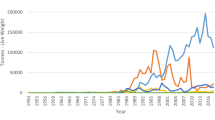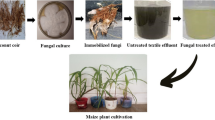Abstract
The increasing demands for seaweeds have promoted the designation of the seaweed industry as the third Entry Point Project (EPP) under the National Key Economic Area (NKEA) initiative of the Economic Transformation Programme (ETP) of the Malaysian government. The farming of carrageenophytes has emerged as a successful enterprise and provides a promising alternative livelihood option for low-income coastal communities in several countries. However, over time, the productivity of the red seaweed crop has declined in some regions due to sourcing of seedlings from single, selected genetic stocks considered to have initially higher yield potential but which resulted in strain fatigue or loss of vigour. To circumvent the crop productivity issues arising from clonal propagation, the raising of planting materials from the development and successful micro-propagation of Kappaphycus has been initiated in order to support the sustainability of selected, farmed carrageenophytes. Three species of Kappaphycus (K. alvarezii (to include 2 strains—brown and green) K. malesianus (aring-aring) and K. striatus) were used in the present study to optimize the use of Ascophyllum Marine Plant Extract Powder (AMPEP K+) which had previously been demonstrated to be effective as a culture medium ingredient, acting as a biostimulant, when applied with the addition of terrestrial plant growth regulators (PGRs). The optimum combination of 3 mg L−1 AMPEP K+ + PGRs was used in out-planting the microplantlets to a sea-based nursery. Salinity and turbidity were found to be positively correlated with growth rates in open water. The use of the brown seaweed-derived extract acting as a biostimulant and as the main ingredient of the cost-effective culture medium for the micro-propagation for all four strains of Kappaphycus tested was highly encouraging, so much so that the treatment has the potential to be promoted as a generic protocol for the economic and commercial mass production of new plantlets (asexual seedlings) which are urgently required for Malaysian seaweed farming to meet its fullest potential.





Similar content being viewed by others
References
Ali MM, Sani MZB, Hi KK, Yasir SM, Critchley AT, Hurtado AQ (2018) The comparative efficiency of a brown algal-derived biostimulant extract (AMPEP), with and without supplemented PGRs: the induction of direct, axis shoots as applied to the propagation of vegetative seedlings for the successful mass cultivation of three commercial strains of Kappaphycus in Sabah, Malaysia. J Appl Phycol 30:1913–1919
Azanza RV, Aliaza T (1999) In vitro carpospore release and germination in Kappaphycus alvarezii (Doty) Doty from Tawi-Tawi, Philippines. Bot Mar 42:281–284
Azanza RV, Ask E (2003) Kappaphycus alvarezii (Doty) Doty carposporeling growth and development in the laboratory. Int Seaweed Symp 17:95–99
Budiyanto, Kasim M, Abadi SY (2019) Growth and carrageenan content of local and tissue culture seed of Kappaphycus alvarezii cultivated in floating cage. AACL Bioflux 12:167–178
Campbell R, Hotchkiss S (2017) Carrageenan industry market overview. In: Hurtado AQ, Critchley AT, Neish IC (eds) Tropical seaweed farming trends, problems and opportunities: focus on Spinosum and Cottonii of commerce. Springer, Dordrecht, pp 193–206
Dawes C, Koch E (1991) Branch, micropropagule and tissue culture of the red algae Eucheuma denticulatum and Kappaphycus alvarezii farmed in the Philippines. J Appl Phycol 3:247–257
Dawes CJ, Trono GC Jr, Lluisma AO (1993) Clonal propagation of Eucheuma denticulatum and Kappaphycus alvarezii for Philippine seaweed farms. Hydrobiologia 260:379–383
Doty MS (1973) Farming the red seaweed, Eucheuma, for carrageenans. Micronesica 9:59–73
Doty MS, Alvarez VB (1981) Eucheuma farm productivity. Proc Int Seaweed Symp 8:688–691
Febriyanti F, Aslan LOM, Iba W, Patadjai AB, Nurdin AR (2019) Effect of various planting distances on growth and carrageenan yield of Kappaphycus alvarezii (Doty) using seedlings produced from mass selection combined with tissue- cultured method. IOP Conf Series: Earth Environ Sci 278:1–8
Hayashi L, Yokoya NS, Kikuchi DM, Oliveira EC (2008) Callus induction and micropropagation improved by colchicines and phytoregulators in Kappaphycus alvarezii (Rhodophyta, Solieriaceae). J Appl Phycol 20:653–659
Hayashi L, Reis RP, Alves dos Santos AA, Castelar B, Robledo D, de Vega GB, Msuya FE, Eswaran K, Yasir S, Ali MJ, Hurtado AQ (2017) The cultivation of Kappaphycus and Eucheuma in tropical and sub-tropical waters. In: Hurtado AQ, Critchley AT, Neish IC (eds) Tropical seaweed farming trends, problems and opportunities: focus on Spinosum and Cottonii of commerce. Springer, Dordrecht, pp 55–90
Hurtado AQ, Biter A (2007) Plantlet regeneration of Kappaphycus alvarezii var. adik by tissue culture. J Appl Phycol 19:783–786
Hurtado AQ, Cheney DP (2003) Propagule production of Eucheuma denticulatum (Burman) Collins et Hervey by tissue culture. Bot Mar 46:338–341
Hurtado AQ, Critchley AT (2019) Recent advances in the use of on-land nurseries for commercial production and out-planting of Kappaphycus seedlings, a carrageen-bearing seaweed. Institute of Ocean and Earth Sciences Monograph Series 17: Taxonomy of southeast Asian seaweeds III (In press)
Hurtado AQ, Yunque DA, Tibubos K, Critchley AT (2009) Use of Acadian marine plant extract powder from Ascophyllum nodosum in tissue culture of Kappaphycus varieties. J Appl Phycol 21:633–639
Luhan MRJ, Mateo JP (2017) Clonal production of Kappaphycus alvarezii (Doty) Doty in vitro. J Appl Phycol 29:2339–2344
Luhan MRJ, Sollesta H (2010) Growing the reproductive cells (carpospores) of the seaweed, Kappaphycus striatum, in the laboratory until out-planting in the field and maturation to tetrasporophyte. J Appl Phycol 22:579–585
Neves FAS, Simioni C, Bouzon ZL, Hayashi L (2015) Effects of spindle inhibitors and phytoregulators on the micropropagation of Kappaphycus alvarezii (Rhodophyta, Gigartinales). J Appl Phycol 27:437–445
Reddy CRK, Kumar GRK, Siddhanta AK, Tewari A (2003) In vitro somatic embryogenesis and regeneration of somatic embryos from pigmented callus of Kappaphycus alvarezii (Doty) Doty (Rhodophyta, Gigartinales). J Phycol 39:610–616
Souza JMC, Castro JZ, Critchley AT, Yokoya NS (2019) Physiological responses of the red algae Gracilaria caudata (Gracilariales) and Laurencia catarinensis (Ceramiales) following treatment with a commercial extract of the brown alga Ascophyllum nodosum (AMPEP). J Appl Phycol 31:1883–1888
Sulistiani E, Soelistyowati DT, Alimuddin YSA (2012) Callus induction and filaments regeneration from callus of cottonii seaweed Kappaphycus alvarezii (Doty) collected from Natuna Islands, Riau Islands Province. Biotropia 19:103–114
Tibubos K, Hurtado AQ, Chritchley AT (2017) Direct formation of axes in new plantlets of Kappaphycus alvarezii (Doty) Doty, as influenced by the use of AMPEP K+, spindle inhibitors and plant growth hormones. J Appl Phycol 29:2345–2349
Umanzor S, Shin S, Marty-Rivera M, Augyte S, Yarish C, Kim JK (2019) Preliminary assessment on the effects of the commercial seaweed extract, AMPEP, on growth and thermal tolerance of the kelp Saccharina spp. from the Northwest Atlantic. J Appl Phycol. https://doi.org/10.1007/s10811-019-01852-3
Wally OSD, Critchley AT, Hiltz D, Craigie JS, Han X, Zaharia LI, Abrams SR, Prithiviraj B (2013) Regulation of phytohormone biosynthesis and accumulation in Arabidopsis following treatment with commercial extract from the marine macroalga Ascophyllum nodosum. J Plant Growth Regul 32:324–339
Yong WTL, Ting SH, Yong YS, Thien VY, Wong SH, Chin WL, Rodrigues KF, Anton A (2014) Optimization of culture conditions for the direct regeneration of Kappaphycus alvarezii (Rhodophyta, Solieriaceae). J Appl Phycol 26:1597–1606
Yunque DAT, Tibubos KR, Hurtado AQ, Critchley AT (2011) Optimization of culture conditions for tissue culture production of young plantlets of carrageenophyte Kappaphycus. J Appl Phycol 23:433–438
Acknowledgments
The first author thanks Acadian Seaplants, Canada, for the sample of AMPEP K+ and various seaweed farmers in Malaysia for their assistance in the field. The first author also thanks the Seaweed Research Unit, Universiti Malaysia Sabah, for the use of laboratory space provided for the study.
Author information
Authors and Affiliations
Corresponding author
Additional information
Publisher’s note
Springer Nature remains neutral with regard to jurisdictional claims in published maps and institutional affiliations.
Rights and permissions
About this article
Cite this article
Ali, M.K.M., Critchley, A.T. & Hurtado, A.Q. Micropropagation and sea-based nursery growth of selected commercial Kappaphycus species in Penang, Malaysia. J Appl Phycol 32, 1301–1309 (2020). https://doi.org/10.1007/s10811-019-02003-4
Received:
Revised:
Accepted:
Published:
Issue Date:
DOI: https://doi.org/10.1007/s10811-019-02003-4




